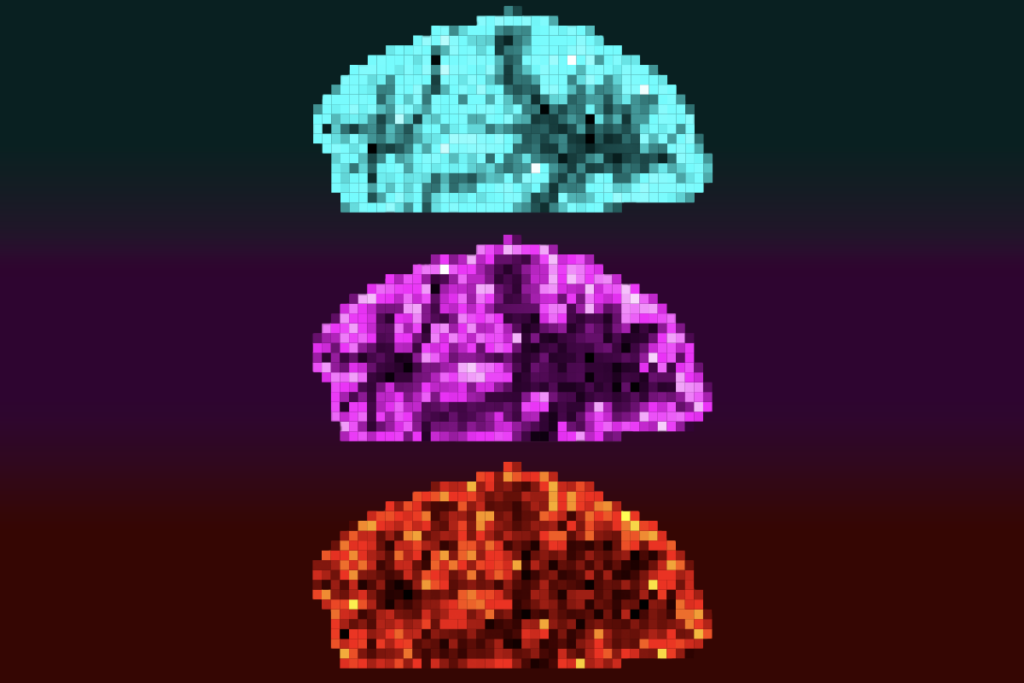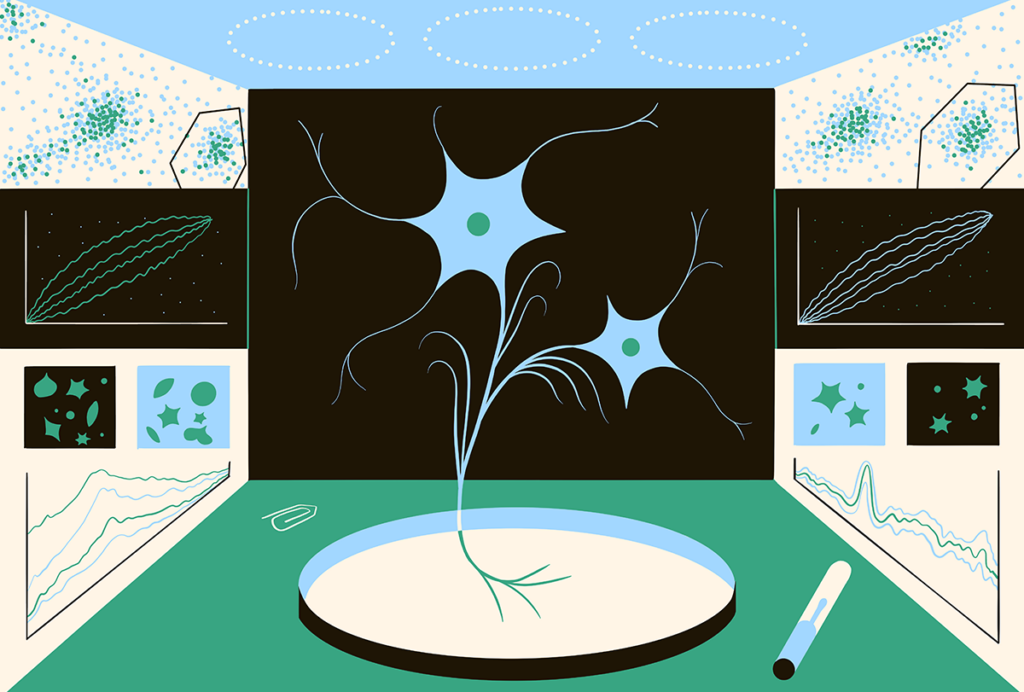SFN 2011
Recent articles
Imaging finds cerebellar changes in autism, other disorders
People with autism have structural changes in parts of the cerebellum that are distinct from those seen in individuals with attention deficit hyperactivity disorder or dyslexia, according to an unpublished meta-analysis presented at the 2011 Society for Neuroscience annual meeting in Washington, D.C.

Imaging finds cerebellar changes in autism, other disorders
People with autism have structural changes in parts of the cerebellum that are distinct from those seen in individuals with attention deficit hyperactivity disorder or dyslexia, according to an unpublished meta-analysis presented at the 2011 Society for Neuroscience annual meeting in Washington, D.C.
Rett, autism mouse brains mimic human disorders
The brains of mice that model Rett syndrome are smaller than normal overall and have differences in specific regions similar to those seen in people with the disorder, according to unpublished research presented Wednesday at the 2011 Society for Neuroscience annual meeting in Washington, D.C.

Rett, autism mouse brains mimic human disorders
The brains of mice that model Rett syndrome are smaller than normal overall and have differences in specific regions similar to those seen in people with the disorder, according to unpublished research presented Wednesday at the 2011 Society for Neuroscience annual meeting in Washington, D.C.
Rat study suggests mechanism for infection-schizophrenia link
Altered function of a brain receptor may help explain the why infection during pregnancy raises the risk for schizophrenia in the offspring, according to an unpublished rat study presented at the 2011 Society for Neuroscience annual meeting in Washington, D.C.

Rat study suggests mechanism for infection-schizophrenia link
Altered function of a brain receptor may help explain the why infection during pregnancy raises the risk for schizophrenia in the offspring, according to an unpublished rat study presented at the 2011 Society for Neuroscience annual meeting in Washington, D.C.
Researchers identify drug candidate for Angelman syndrome
Researchers have identified a compound that shows promise as a treatment for Angelman syndrome, a developmental disorder related to autism. The unpublished results were presented Tuesday at the 2011 Society for Neuroscience annual meeting in Washington, D.C.

Researchers identify drug candidate for Angelman syndrome
Researchers have identified a compound that shows promise as a treatment for Angelman syndrome, a developmental disorder related to autism. The unpublished results were presented Tuesday at the 2011 Society for Neuroscience annual meeting in Washington, D.C.
Video: Birds do it for autism research
Studying bird species such as the zebra finch can help researchers understand language difficulties in autism, Stephanie White told SFARI.org in a video interview at the 2011 Society for Neuroscience annual meeting in Washington, D.C.

Video: Birds do it for autism research
Studying bird species such as the zebra finch can help researchers understand language difficulties in autism, Stephanie White told SFARI.org in a video interview at the 2011 Society for Neuroscience annual meeting in Washington, D.C.
Researchers map microRNAs in autism brains
Researchers have charted the expression of tiny pieces of RNA in postmortem brain tissue from people with autism, according to unpublished research presented Tuesday at the 2011 Society for Neuroscience annual meeting in Washington, D.C.

Researchers map microRNAs in autism brains
Researchers have charted the expression of tiny pieces of RNA in postmortem brain tissue from people with autism, according to unpublished research presented Tuesday at the 2011 Society for Neuroscience annual meeting in Washington, D.C.
Folate low in spinal fluid of children with autism, study says
A small fraction of young children with autism have low levels of folate, a B vitamin, in their cerebrospinal fluid, according to unpublished research presented at the 2011 Society for Neuroscience annual meeting in Washington, D.C.

Folate low in spinal fluid of children with autism, study says
A small fraction of young children with autism have low levels of folate, a B vitamin, in their cerebrospinal fluid, according to unpublished research presented at the 2011 Society for Neuroscience annual meeting in Washington, D.C.
Fruit flies pin down autism candidates
Looking at flies that express elevated levels of UBE3A, a gene that is duplicated in some people with autism, researchers have identified 81 proteins that may be linked to the disorder, according to unpublished results presented Tuesday at the 2011 Society for Neuroscience annual meeting in Washington, D.C.

Fruit flies pin down autism candidates
Looking at flies that express elevated levels of UBE3A, a gene that is duplicated in some people with autism, researchers have identified 81 proteins that may be linked to the disorder, according to unpublished results presented Tuesday at the 2011 Society for Neuroscience annual meeting in Washington, D.C.
Video test measures subtleties of social cognition
Social cognition tests using videos of actors performing emotional expressions and scenes can measure subtle impairments characteristic of high-functioning people with autism, according to unpublished research presented at the Society for Neuroscience annual meeting in Washington, D.C.

Video test measures subtleties of social cognition
Social cognition tests using videos of actors performing emotional expressions and scenes can measure subtle impairments characteristic of high-functioning people with autism, according to unpublished research presented at the Society for Neuroscience annual meeting in Washington, D.C.
MET variants influence connectivity in children with autism
Individuals who carry an autism-linked common variant in the MET gene have abnormally low brain connectivity, according to unpublished research presented at the 2011 Society for Neuroscience annual meeting in Washington, D.C.

MET variants influence connectivity in children with autism
Individuals who carry an autism-linked common variant in the MET gene have abnormally low brain connectivity, according to unpublished research presented at the 2011 Society for Neuroscience annual meeting in Washington, D.C.
Explore more from The Transmitter
Mitochondrial ‘landscape’ shifts across human brain
Evolutionarily newer regions sport mitochondria with a higher capacity for energy production than older regions, according to the first detailed map of the organelles in a tissue slice, adding to mounting evidence that the brain features a metabolic gradient.

Mitochondrial ‘landscape’ shifts across human brain
Evolutionarily newer regions sport mitochondria with a higher capacity for energy production than older regions, according to the first detailed map of the organelles in a tissue slice, adding to mounting evidence that the brain features a metabolic gradient.
Expediting clinical trials for profound autism: Q&A with Matthew State
Aligning Research to Impact Autism, a new initiative funded by the Sergey Brin Family Foundation, wants to bring basic science discoveries to the clinic faster.

Expediting clinical trials for profound autism: Q&A with Matthew State
Aligning Research to Impact Autism, a new initiative funded by the Sergey Brin Family Foundation, wants to bring basic science discoveries to the clinic faster.
This paper changed my life: Shane Liddelow on two papers that upended astrocyte research
A game-changing cell culture method developed in Ben Barres’ lab completely transformed the way we study astrocytes and helped me build a career studying their reactive substates.

This paper changed my life: Shane Liddelow on two papers that upended astrocyte research
A game-changing cell culture method developed in Ben Barres’ lab completely transformed the way we study astrocytes and helped me build a career studying their reactive substates.